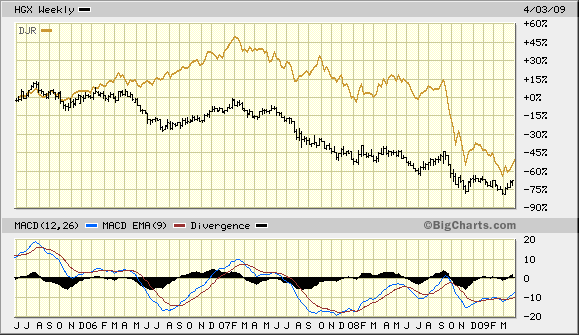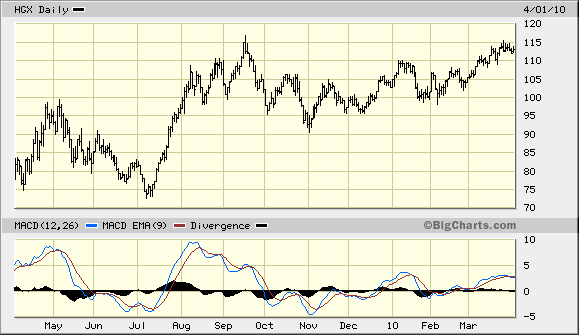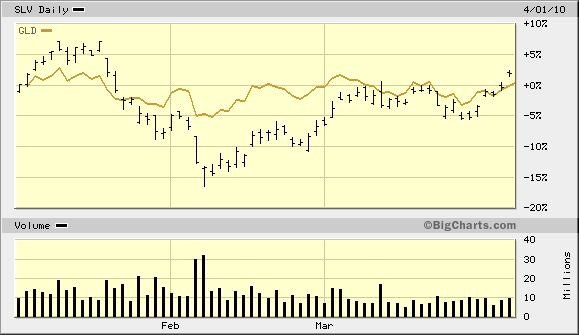Critical Juncture for U.S. Housing Market, Gold
Housing-Market / Housing Stocks Apr 04, 2010 - 07:36 AM GMTBy: Clif_Droke
 Let's turn our attention to real estate for a minute. The thorn in the economic recovery's side, after all, has been the mortgage market. Investors are worried that with so many mortgage holders under water, the hoped for economic reversal has no chance to stick. Debt relief has been a paramount concern since the credit crisis began, and rightfully so. Yet it has been elusive. Lenders have stubbornly held off in offering anything in the way of substantial relief to the legions of debtors who could use a break.
Let's turn our attention to real estate for a minute. The thorn in the economic recovery's side, after all, has been the mortgage market. Investors are worried that with so many mortgage holders under water, the hoped for economic reversal has no chance to stick. Debt relief has been a paramount concern since the credit crisis began, and rightfully so. Yet it has been elusive. Lenders have stubbornly held off in offering anything in the way of substantial relief to the legions of debtors who could use a break.
Until now that is...
Bank of America recently announced a new program aimed at reducing mortgage principal for homeowners that owe more than 120 percent of their home's value. In what came as a surprise to many, the bank said it will actually reduce principal owed for underwater borrowers and those with so-called negative amortization loans.
Reporting on the news announcement, journalist Charles Feldman wrote, "The BofA announcement marks a startling shift for the beleaguered bank, which has been dogged by complaints that it has been unresponsive to homeowners looking for help with mortgages they can no longer afford. The bank has also been stung by a string of embarrassing incidents where it has wrongfully seized homes for foreclosure.
"The BofA program will offer an 'earned principal forgiveness' up to 30 percent in two stages. The program will be offered to borrowers of certain subprime, Pay-Option and prime two-year hybrid mortgages that qualify for BofA's National Homeownership Retention Program (NHRP), created in 2008, and are at least 60 days delinquent with current loan-to-value (LTV) ratios of 120 percent or higher." The program is expected to be operational by May.
Reading the latest news brings to mind the old saying made famous by Freeman Tilden. Tilden wrote the classic Depression Era book, "A World in Debt," which was probably the first - and arguably the best -- attempt by a layman at explaining the debt phenomenon and its consequences in terms that actually made sense. Tilden observed that although debt always brings the world's economies to the brink of disaster, debtors are always ultimately thrown a lifeline by banks and governments in order to save the system of usury. As Tilden put it, "Though a man should live as long as Methusalah, it would pay him to never be out of debt." He was of course referring to the tendency for debtors to be bailed out of their difficulties at the expense of their creditors.
No sooner did mortgage holders get some good news, however, they were given yet another reason to fret, this time from the Federal Reserve. Speculation is rampant concerning the housing market outlook after the withdrawal this week of an important support. On April 1, the Fed ended its program to purchase $1.25 trillion of mortgage-backed securities and about $175 billion of housing-agency debt. The removal of the Fed-backed pillar comes against a backdrop of falling home sales in January and February and a vacancy rate of homes for sale of 2.1 million in Q4 2009.
The opinion of the more reputable real estate experts must be considered here and can't lightly be dismissed. My friend Robert Campbell, author of the book "Timing the Real Estate Market" and editor of the Campbell Real Estate Timing Letter, falls into the bearish camp. In his latest newsletter, he questions the stability of the real estate recovery. After hitting an 11 year low in January 2009, existing home sales as reported by NAR went into a near vertical rise until November 2009, at which time existing home sales hit a 2.5 year high. Campbell observed, "In December 2009 and January 2010, however, home sales plunged by 7.2% and 16.7% -- which not only took home sales to a 7 month low but it was the worst two-month decline on record." Many wonder if this is the start of renewed real estate decline or merely a temporary phenomenon.
There does to seem to be growing optimism among the ranks of economists in the wake of the 18-month financial market recovery, however. Many believe that a combination of an improved job market this spring, a benign monetary policy and lower (read more affordable) housing prices will act as a shock absorber for the housing market after the Fed's withdrawal. These optimists also foresee recovery in real estate as the year progresses if the employment situation shows improvement from here. Friday's (April 2) release of increased job numbers, they assert, was a step in the right direction.
As reported by the April 5 issue of Business Week, credit conditions are showing signs of improving and this may also lend itself to a stronger housing market. According to BW, a net 13.2% of banks surveyed by the Fed in January reported that they tightened lending standards on prime mortgages in the fourth quarter, the smallest percentage of the last three years.
On the other side of the pond the view of the U.S. housing market is much less optimistic. The latest issue of The Economist anticipates a second dip in the housing market and is, in the words of the headline article, "Waiting for the other shoe to drop." Writes The Economist, "A renewed decline in the housing market is not inevitable, but it is starting to look increasingly likely. And if prices start to drop once again, causing both household wealth and construction employment to fall, while boosting the rate of defaults, the broader economic recovery, which is still fragile, may very well suffer as a result of housing's woes."
Whether you choose to accept the rosy picture painted by the optimists or the decidedly less friendly outlook enunciated by the pessimists, the real estate outlook remains the cornerstone of the U.S. economic recovery. The 2007-2008 financial crisis started with real estate and the recovery. In order for the recovery that began in 2009 to continue will almost certainly require at least some improvement in commercial and residential property markets. But where do we go to find the answers to the real estate outlook conundrum? Sifting through the contradictory forecasts and opinions of the experts would be a futile task, therefore we'll turn to the one place where we can get the best possible advice without any of the confusion that normally attends financial forecasts. I'm referring of course to the market itself, which is where the ultimate verdict is rendered on the economy's fortunes.
"New home starts fell 5.9% in February due to winter storms, the latest blow for the housing market," rang to the Wall Street Journal. Despite the plethora of negative news for housing lately, however, neither the Housing Index (HGX) nor the Dow Jones REIT Index (DJR) appear very concerned by this, nor are they reeling from the weather-related blows that have plagued the market for home sales this winter. Indeed, one of the best places to get answers on the housing outlook is from the Housing Sector Index (HGX), which is a reflection of the average prices of homebuilder stocks. What the HGX and DJR have apparently been seeing is better news (and presumably better weather) ahead for the housing market.

"Yes, but doesn't the DJR sometimes lag the housing market?" It's true that DJR blew off to a new high into early 2007, well after the housing bubble peak. But HGX is a fairly reliable indicator for the physical housing market, having peaked well before DJR in 2005, anticipating even the U.S. real estate "broad market" peak. HGX is thus a much more reliable leading indicator for the housing market. HGX is currently testing its 52-week high from last September and if it makes a new high from here, the message would be undeniably a positive one for housing.

So as you can see, the housing market has arrived at another critical juncture. A breakout above the September 2009 high in the Housing Index would telegraph an optimistic message for the housing market outlook in the months ahead. This index is more valuable than any housing-related data the government can provide since it represents where those "in the know" are doing with their money as it relates to the housing market outlook.
On the subject of REITs, an editorial piece appearing a recent edition of Barron's asks, "Is a rebound in the works for REIT dividends?" The piece went on to point out that for the first time since the housing bust, real estate trusts are resuming cash payouts. As it turns out, some 70% of real estate investment trusts cut or eliminated their dividend following the real estate crash, according to Barron's. Of course this is another sign of returning strength as the recovery continues but by no means should be read as a message that the long-term housing cycle has turned up. My best "guesstimate," based on the long-term Kress cycles, is that real estate will see a general recovery continue up until about 2012 when the last of the long-term cycles, namely the 6-year cycle, peaks and the final "hard down" phase of the 40-year and 60-year cycles begins.
So much for real estate, now what about the market for gold? Much like the housing market, gold has also arrived at somewhat of a critical juncture. Investors seemed to be asleep on the precious metals and one gets the sense that the market is ripe for a surprise "spring rally." As we've been talking about in recent weeks, the intermediate-term internal momentum configuration for the gold stocks isn't exactly optimal for an extended rally. But the short-term momentum index is still rising and could lend itself to a rally attempt by the gold and silver shares that are already in a position of relative strength.
Another theme we've been focusing on is the "trading range game" that traders have obviously been playing lately in an attempt at capitalizing on the short-term rising momentum within the industry. Gold and silver stocks that have been consolidating in a tight, lateral trading range well above their February lows and above their rising immediate-term trend lines are the ones that are most likely to be run up to the upper band of the interim trading range (i.e. the January highs). Some have already achieved this conservative upside objective and a few have made new highs. Admittedly the trading range game is speculative in view of the declining interim momentum but it would be surprising if the leading gold and silver stocks didn't enjoy one more run up before the short-term internal momentum peaks.

Last week the iShares Silver Trust ETF (SLV), our proxy for the silver price, broke out above its March high in its challenge of the previous high from January. It's common secular precious metals bull markets for silver to outperform gold. Moreover, silver strength coming out of a lateral consolidation typically serves as a precedent for a gold price breakout. The SPDR Gold Trust ETF (GLD) is our proxy for the gold price. Using SLV as a leading indicator, we look for a test of the January high in the GLD.
Cycles
Over the years I've been asked by many readers what I consider to be the best books on stock market cycles that I can recommend. While there are many excellent works out there on the subject of technical and fundamental analysis, chart reading, etc., precious few have addressed the subject of market cycles. Of the relatively few books on cycles that are available, most don't even merit mentioning. I've read only one book in the genre that I can recommend - The K Wave by David Knox Barker - but even that one doesn't deal directly with stock market cycles but instead with the economic long wave. I'm pleased to announce, however, that after nearly 10 years of research and one year of writing, I've completed a book on the subject that I believe will meet the critical demands of most cycle students. It's entitled, The Stock Market Cycles, and is available for sale at: http://clifdroke.com/books/Stock_Market.html
By Clif Droke
www.clifdroke.com
Clif Droke is the editor of the daily Gold & Silver Stock Report. Published daily since 2002, the report provides forecasts and analysis of the leading gold, silver, uranium and energy stocks from a short-term technical standpoint. He is also the author of numerous books, including 'How to Read Chart Patterns for Greater Profits.' For more information visit www.clifdroke.com
Clif Droke Archive |
© 2005-2022 http://www.MarketOracle.co.uk - The Market Oracle is a FREE Daily Financial Markets Analysis & Forecasting online publication.



